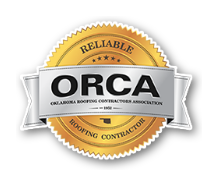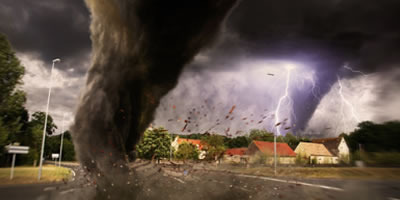Storm Damage 101
Roof Damage
When most people think of roofing shingles, they are actually thinking of asphalt shingles, the most common type of shingles in the country. Asphalt shingles are made from asphalt re-enforced with either organic material or fiberglass and they are coated with small metallic surface granules that protect the roof from UV-rays that speeds deterioration. Asphalt shingles come in a wide range of colors, sizes and styles. During severe storms asphalt shingles can be seriously damaged and require repair or replacement.
Hail Damage
Roofs are the most commonly damaged part of a home or business in hailstorms. A damaged shingle may allow water to seep through the roof causing additional damage to the roof deck, support structure, interior walls, or windows, and can cause leaking, staining on walls and flooding inside your home. Leaking roofs lead to costly damages and many insurance policies have strict time limits on submitting claims after hailstorms, so it's in your best interest to act fast after hailstorms and start the repairs process, if necessary.
- Asphalt Shingle Damage: On an asphalt roof, hail damage looks like a dark spot, or bruise, where the roofing granules have been knocked away (look in gutters for accumulation of granules). In some cases you may find holes, cracking, or missing shingles on roofs with hail damage. This can result in leaking and serious water damage, which can lead to mold formation and wood rot, which can compromise the structural integrity of your roof resulting in collapse.
- Other Types of Shingle Damage: Shake (wood), metal, tile, and slate roof shingles can all suffer damage from hailstorms. Due to the materials, each type of shingle shows unique signs of damage from hail. If shingles are cracked, missing, torn or split at seams, you should definitely have a damage inspection performed. Similarly, if you notice leaking inside your home after a hailstorm, get an inspection right away.
Common Signs of Hail Damage
- Bruises or dented asphalt shingles
- Cracked or broken tile, slate, or concrete shingles
- Granules collecting in gutters or downspouts
- Leaks in your roof or ceiling
- Dents on vents, gutters or flashing
Tornado Damage
After a tornado, you may notice split seams and torn or missing shingles. This can result in leaking and serious water damage, which can lead to mold formation and wood rot, which can compromise the structural integrity of your roof resulting in collapse.
Wind Damage
In severe wind storms, it is common for shingles or sections of the roof to be missing altogether.
On other types of roofs, including shake (wood), metal, tile and slate, damage can include broken or cracked shingles, missing shingles, torn or split seams, and missing sections of the roof. If a tree limb or other debris has fallen onto your roof during the storm, you may have structural damage, and will want to exercise extreme caution.
Ice Dams
Ice dams are a pervasive and damaging winter roofing problem caused by heat that collects in the attic and warms the roof, except at the eaves. Left untreated, ice dams can cause serious damage to your roof, gutters, paint, insulation, drywall, structure and even contribute to mold.
Ice dams form when melting snow on a roof runs off and refreezes at the edge of a roof. This condition occurs when the snow is melted by escaping heat from the attic space, creating water running between the snow and the warm roof surface, then freezing and turning to ice when it gets past the exterior wall and hits a cold unheated roof edge or gutter. As the bottom of the snow pack continues to melt, water continues to flow down the roof surface until it hits the ice, thereby creating a larger and larger ice dam. Ironically, ice dams occur most commonly after a heavy snow because snow is a great insulator.
If this situation continues, the ice can work its way back up the roof edge, get under shingles, melt and leak into the exterior wall, home or attic. Damage from ice dams may not be readily apparent. As the ice melts and possibly drips into the wall or attic, insulation can be become wet and lose its ability to perform. In some cases if the right temperature and humidity exist, mold may begin to grow in the attic. Often paint will peel or blister weeks or months after the ice dam has melted as moisture from the leak in the wall or ceiling cavities tries to leave and pushes outward.
Sun Damage
As soon as a roof is installed the sun begins to deteriorate the material. Every single day (even cool and cloudy days) the UV rays from the sun damage and break down the roof. Under the exposure of UV rays of the sun, free molecules of oxygen mix with heated hydrocarbons in asphalt and deterioration begins.
Molecular breakdown by the sun dries out the oils in the roof. The roofing material becomes dry and brittle. Eventually it loses its waterproofing qualities.
Heat accelerates the breakdown process. The damage done from the UV rays is greatly sped up when the weather is hot. A typical rooftop gets up to 160º on a hot summer day when the air temperature is 90º. Over time the roof looses flexibility and becomes weak.
The roof expands and contracts every day. This is referred to as thermal shock. The sun’s heat makes the roof stretch out in the day. At night, the evening cools the roof causing it to contract. Flashings and drains are typically metal. They expand and cool much quicker than the roof membrane. Over time, the tremendous strain from the thermal shock causes metal drains and flashings to pull away from the roof assembly at these critical areas. The movement also causes the roof to split.






